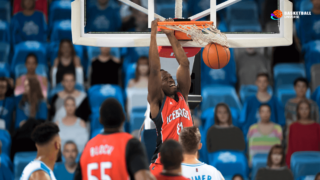
In the exhilarating world of basketball, strategies and tactics are essential for teams looking to outsmart their opponents. One such tactic that both delights and puzzles fans is the 3-1-1 Full-Court Press. If you’re keen on exploring this high-intensity defensive strategy, you’ve come to the right place. By the end of this blog post, we’ll dive deep into the fundamentals, objectives, and players’ roles in executing a successful 3-1-1 Full-Court Press. So lace up those sneakers, and get ready for a court-side exploration of an aggressive and captivating basketball tactic!
What’s a 3-1-1 Full-Court Press in Basketball?
A 3-1-1 Full-Court Press is an aggressive defensive basketball strategy in which a team applies full-court pressure on their opponents by assigning three players near the inbounder, one player at half-court, and one player near their own basket. This formation aims to disrupt the opposing team’s offensive flow, create turnovers, and force hurried shots, ultimately providing more scoring opportunities for the pressing team.
Unlocking the Power of the 3-1-1 Full-Court Press
The unique aspects of the 3-1-1 Full-Court Press make it an excellent addition to any coach’s arsenal or fan’s knowledge. With ample information and useful tips provided in this section, you will be ready to gain a deeper understanding of this powerful strategy in the fantastic world of basketball. Let’s dive in and explore each component step-by-step to ensure you can implement the 3-1-1 Full-Court Press seamlessly in your next game or simply impress your friends with your expert knowledge.
The 3-1-1 Formation and Players’ Roles
Each player has a specific role within the 3-1-1 Full-Court Press. By understanding these roles and the overall formation, you can ensure a successful press execution.
The Frontline: Three Players Near the Inbounder
At the forefront of this defense are three players positioned close to the opponent’s inbounder. Their primary responsibility is to disrupt the flow of the ball as soon as it’s inbounded. They converge around the ball handler, making it difficult for the opposing team to set up their offensive plays. These three players have different roles:
- Player 1 (P1): The key interceptor placed closest to the inbounder; P1 actively contests the inbound pass, attempting to steal the ball or deflect it.
- Player 2 (P2): Positioned on the side closer to the middle of the court, P2 takes responsibility for guarding the first available pass to the inbounder’s left or right, acting as a secondary interceptor.
- Player 3 (P3): Placed near the baseline, P3 covers opponents closer to the basket, effectively securing the frontline against any breakthroughs.
The Midfielder: One Player at Half-Court
Stationed around the half-court line, Player 4 (P4) serves as the team’s midfield captain. The main goal for the midfielder is to be a defensive stopper by providing help in both the backcourt and frontcourt based on the game’s flow. P4 performs three crucial duties:
- Step in: P4 steps in and squares up against the opposing team’s ball handler if they break through the troop of defenders. Containing the dribbler ensures they do not make an easy shot attempt or pass.
- Safety Net: P4 also acts as a safety net, providing support in case the defenders in the frontline meet a potential breakdown or trap.
- Intercept: P4 looks for an opportunity to intercept any long passes attempted by the opponent, especially under high pressure situations.
The Last Line of Defense: One Player Near the Basket
Lastly, we have Player 5 (P5), who serves as the team’s final line of defense. Positioned near their basket, P5’s primary task is to discourage the opposing team from attempting to score by:
- Helping on Defense: P5 jumps into the action, providing help when needed to contest shots, box out opponents, and battle for rebounds.
- Preventing Fast-Breaks: By watching for long passes intended to enable a fast-break layup, P5 is instrumental in foiling the opponent’s fast-break attempts.
Executing the 3-1-1 Full-Court Press: Key Techniques
Now that you have a deep understanding of the players’ roles in the 3-1-1 formation, let’s discuss critical techniques and strategies needed for flawless execution, ensuring success during the game.
Consistent Communication
Consistent communication among players on the court is crucial for an effective 3-1-1 Full-Court Press. Players must signal about potential loops in the defense and make adjustments as needed to maintain an effective press. By continuously communicating, the team can move as a unified force, closing gaps and limiting scoring opportunities for their opponents.
Trapping the Opponents
The primary objective of the 3-1-1 Full-Court Press is to force the opposition into making mistakes. Hence, players must be aggressive with their trapping. This involves applying pressure to the ball handler and sealing off their passing lanes, making them susceptible to turnovers or hurried shots. Swift recoveries and sharp rotations are integral to successful trapping.
Diverting the Ball to the Sidelines
Another essential strategy is to divert the ball to the sidelines, as this can act as an additional defender by limiting the ball handler’s space for maneuvering. By funneling the ball toward the sidelines, players can increase the likelihood of trapping or stealing the ball from the opponent.
Maintaining High Intensity
The 3-1-1 Full-Court Press demands a high energy level from the players. Although tiring, maintaining an intense hustle from start to finish is vital for the strategy’s effectiveness. The more assertive and persistent the press, the greater the chance of forcing the opponent into errors and creating scoring opportunities.
Adjusting the 3-1-1 Full-Court Press Based on Opponent Strategy
Opposing teams may devise game plans to counteract the 3-1-1 Full-Court Press. However, understanding these likely strategies and making necessary adjustments can strengthen the press’s effectiveness.
Handling Diverse Offensive Setups
The 3-1-1 Press should be flexible enough to tackle various offensive formations. Teams might engage in quick passes or employ skilled ball handlers to escape the pressure. Knowing the common offensive setups and adapting the defense accordingly can provide a competitive advantage.
Countering the Fast-Break Approach
Some teams might rely on a swift fast-break approach to circumvent the press. P5, the last line of defense, is instrumental in preventing such attempts by anticipating long passes and preparing for rim protection.
Dealing with Targeted Short Passes
Opponents might opt for precise and targeted short passes to maintain possession and advance the ball. In this case, the players must be ready to intercept by maintaining active hands and agile footwork during the press.
Responding to Changes in Game Pace
Teams might run a slow-paced offense to handle the pressure or shift to a high-tempo game plan to catch the defense off guard. The pressing team’s players should adjust accordingly by coordinating their efforts and applying consistent pressure as the game’s tempo changes.
Advantages of the 3-1-1 Full-Court Press
The 3-1-1 Full-Court Press can provide various benefits, including increased scoring opportunities and significant pressure on the opposing team:
- Forcing turnovers: The relentless pressure applied by the press disrupts the opponent’s offensive flow, causing them to make unforced errors, which may result in more turnovers.
- Hurrying the offense: Pressing teams can force their opposition to take rushed shots by putting the ball handler under continuous strain, yielding unfavorable shot selections.
- Exhausting the opposition: The energetic gameplay can wear down opponents, potentially leading to more scoring opportunities for the pressing team and a psychological edge.
- Easily adjustable: The 3-1-1 Full-Court Press can be adapted to various game situations or opponent strategies, offering a versatile defensive weapon.
3-1-1 Full-Court Press: A Pressing Force to Reckon With
Now armed with the knowledge of the intricacies of the 3-1-1 Full-Court Press, you are well-equipped to utilize this strategy in your gameplay, elevate your coaching prowess, or simply impress others with your incredible basketball savoir-faire. The 3-1-1 Full-Court Press is a powerful defensive tool with immense potential when executed diligently. Be sure to incorporate these tips, strategies, and key techniques for an outstanding performance on the court.
Strengths and Weaknesses of the 3-1-1 Full-Court Press
As with any tactic in basketball, the 3-1-1 Full-Court Press presents both strengths and weaknesses. Recognizing these aspects will allow coaches, players, and fans to understand when and how to implement this strategy effectively.
Strengths
- Intimidation factor: An aggressive press intimidates opponents, causing them to play outside their comfort zone, which could lead to more mistakes and turnovers.
- Adaptability: As mentioned earlier, the 3-1-1’s flexibility allows for adaptation against various offensive strategies, making it difficult for opponents to exploit defensive weaknesses.
- Glue-like pressure: The 3-1-1 Full-Court Press consistently applies pressure on the opponents, reducing their time to prepare and execute offensive plays.
- Momentum shifter: A well-executed press can boost team morale and shift the momentum in their favor, especially when forcing a turnover or scoring a quick basket.
Weaknesses
- Vulnerable to quick ball movement: Rapid and well-executed ball movement could potentially break the press, leading to easy scoring opportunities for the opponent.
- Energy-consuming: High-intensity pressing throughout the game can exhaust players. Coaches must effectively manage the fatigue factor by rotating players to sustain the press’s effectiveness.
- Chance of foul trouble: Over-aggressiveness can lead to more personal fouls which, in turn, might result in key players sitting on the bench or the opposition taking advantage of bonus free throw situations.
- Risk of mismatches: Frequent position-switching during the press could lead to mismatches, giving the opponent opportunities to exploit weaker defenders.
Implementing the 3-1-1 Full-Court Press in Practice
To maximize the effectiveness of the 3-1-1 Full-Court Press on the court, incorporating it into practice routines is crucial. The following exercises can help players understand their roles and gain practical experience executing the press:
Drills to Perfect the 3-1-1 Press
- Defensive shell: This drill involves practicing the defensive alignment without an opponent, helping players recognize their correct positioning and rotations during the press.
- 3-on-3 Half-Court Traps: By simulating half-court trapping situations, players build skill in sealing off passing lanes and applying pressure on the ball handler.
- 5-on-5 Press Break: Conducting a full-court scrimmage, with one team applying the 3-1-1 press and the other team attempting to break it, aids in building the desired muscle memory and awareness when executing the press during games.
- Positional drills: Targeting specific player responsibilities in smaller groups or individually allows for focused development of the skills required for each role within the press.
Spotting the 3-1-1 Full-Court Press in Professional Basketball
While the 3-1-1 Full-Court Press isn’t as prevalent in professional basketball as it is in lower leagues, it has been utilized by some noteworthy teams throughout history:
Notable Teams and Coaches
- Arkansas Razorbacks: Under the leadership of head coach Nolan Richardson, the Razorbacks passionately adopted the “40 Minutes of Hell” approach, determinedly pressing their opponents for the entire game, which contributed to their 1994 NCAA National Championship win.
- Rick Pitino: Current head coach Rick Pitino used the full-court press extensively and successfully during his tenures at the University of Kentucky, University of Louisville, Boston Celtics, and New York Knicks.
- Team Press Virginia: The West Virginia University men’s basketball team, also known as “Press Virginia,” often utilizes an aggressive full-court press during their gameplay to disrupt the rhythm of their opponents.
By referencing the expertise and success of the above-mentioned coaches and teams, implementing the 3-1-1 Full-Court Press can become even more effective for both aspiring and experienced coaches and players.
Frequently Asked Questions
For those who wish to further their understanding of the 3-1-1 Full-Court Press in basketball, this section delves into commonly asked questions that aim to address any lingering curiosities or doubts. Expand your knowledge by exploring these insightful questions and concise answers.
1. Can the 3-1-1 Full-Court Press be used throughout the entire game?
While possible, using the 3-1-1 Full-Court Press throughout the entire game can be physically exhausting for the players. It is typically most effective when strategically deployed at specific moments or combined with other defensive strategies.
2. Is the 3-1-1 Full-Court Press suitable for every team?
Given the right personnel and commitment to the strategy, the 3-1-1 Full-Court Press can be suitable for most teams. It’s important to understand the strengths and weaknesses of your players and adjust the press to maximize its effectiveness.
3. How does a team train for a 3-1-1 Full-Court Press?
Training for the 3-1-1 Full-Court Press involves practicing individual skills, specific positional responsibilities, team coordination, and communication. Implementing targeted drills and full-court scrimmages can be effective in developing the required skills.
4. Can a team use other types of presses alongside the 3-1-1 Press?
Yes, teams can use other types of presses, such as the 2-2-1, 1-2-1-1, or Man-to-Man Full-Court Press in conjunction with the 3-1-1 Press. Switching between presses can keep the opposition guessing and enhance a team’s defensive repertoire.
5. When should a team avoid using the 3-1-1 Full-Court Press?
Teams should avoid using the 3-1-1 Full-Court Press if their players struggle with maintaining its high intensity, if they are frequently mismatched against opponents, or if they face foul trouble. Teams should always be aware of their limitations and adjust their strategies accordingly.
6. How does the 3-1-1 Full-Court Press compare to other full-court presses?
Compared to other full-court presses, the 3-1-1 Press is more aggressive in nature and relies on the frontline pressuring the inbounder. Other presses like the 2-2-1 or 1-2-1-1 focus more on guarding specific passing lanes or maintaining a particular zone of the court.
7. How can players efficiently conserve energy when implementing the 3-1-1 Full-Court Press?
One way for players to conserve energy during the 3-1-1 Full-Court Press is through regular rotation and substituting of players. Coaches should use bench depth and strategic timeouts to help manage player fatigue effectively.
8. Are there any famous games or plays where the 3-1-1 Full-Court Press was instrumental in securing a victory?
While specific plays might be challenging to pinpoint, the Arkansas Razorbacks’ 1994 NCAA National Championship victory is often associated with their “40 Minutes of Hell” approach, which incorporated the 3-1-1 Full-Court Press as part of their relentless pressing strategy.
9. How do I know if my team is ready to implement the 3-1-1 Full-Court Press in actual games?
If your team demonstrates a clear understanding of the press, can execute it consistently during practice, and adapts well to different offensive strategies, they are likely ready to implement the 3-1-1 Full-Court Press during actual games.
10. How do I adjust the 3-1-1 Full-Court Press against teams with great ball handlers?
Against opponents with exceptional ball handlers, consider increasing the pressure on passing lanes and maintaining a tighter defense. Utilize double teams or sporadically switch defensive strategies to keep the opposition off-balance.
11. Can youth or amateur teams effectively use the 3-1-1 Full-Court Press?
Yes, youth and amateur teams can effectively use the 3-1-1 Full-Court Press with proper coaching, practice, and understanding of the strategy’s fundamentals. It can provide these teams with valuable experience in playing aggressive defense and developing strong communication skills on the basketball court.
12. Is there a risk of the pressing team conceding more points when employing the 3-1-1 Full-Court Press?
While there may be a risk of conceding more points due to potential mismatches or breakdowns, the aim of the 3-1-1 Full-Court Press is to create increased scoring opportunities for the pressing team, counterbalancing the points conceded.
13. Would the 3-1-1 Full-Court Press be effective against professional teams with strong offensive guards?
While professional teams with strong offensive guards may have an advantage in handling the pressure, the 3-1-1 Full-Court Press can still be effective if used strategically or as a way to disrupt the opponent’s offensive rhythm intermittently.
Featured Posts
- No pillar pages found.





